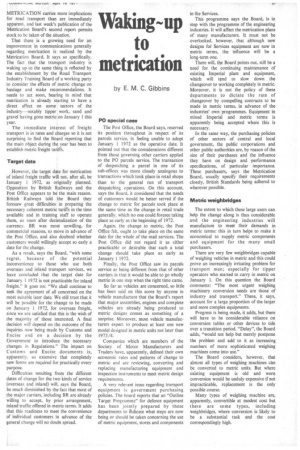Waking up to metrication
Page 39

If you've noticed an error in this article please click here to report it so we can fix it.
by E. M. C. Gibbins
PO special case The Post Office, the Board says, reserved its position throughout in respect of its parcels service, in feeling unable to adopt January 1 1972 as the operative date. It pointed out that the considerations different from those governing other carriers applied to the PO parcels service. The transaction of despatching a parcel in one of its sub-offices was more closely analogous to transactions which took place in retail shops than to the general run of transport despatching operations. On this account, says the Board, it considered that the needs of customers would be better served if the change to metric for parcels took place at the same time as the change in retail trade generally, which no one could foresee taking place as early as the beginning of 1972.
Again, the change to metric, the Post Office felt, ought to take place on the same date for the whole of the mail services. The Post Office did not regard it as either practicable or desirable that such a total change should take place as early as January 11972.
Finally, the Post Office saw its parcels service as being different from that of other carriers in that it would be able to go wholly metric in one step when the right time came.
So far as vehicles are concerned, so little has been said on this score by anyone in vehicle manufacture that the Board's report that major assemblies, engines and complete vehicles are already being produced to metric designs comes as something of a surprise. Moreover, most vehicle manufacturers expect to produce at least one new model designed in metric units not later than 1973/4.
Companies which are members of the Society of Motor Manufacturers and Traders have, apparently, defined their own economic rates and patterns of change to metric and are reviewing, converting and replacing manufacturing equipment and inspection instruments to meet metric design requirements.
A very relevant issue regarding transport equipment is government purchasing policies. The board reports that an "Outline Target Programme" for defence equipment has been jointly prepared by these departments to indicate what steps are now being or should be taken concerning the use of metric equipment, stores and components in the Services.
This programme says the Board, is in step with the programme of the engineering industries. It will affect the metrication plans of many manufacturers. It must not be overlooked, however, that although new designs for Services equipment are now in metric terms, the influence will be a long-term one.
There will, the Board points out, still be a need for the continuing maintenance of existing Imperial plant and equipment, which will tend to slow down the changeover to working completely in metric. Moreover, it is not the policy of these departments to dictate the rate of changeover by compelling contracts to be made in metric terms, in advance of the industries' own programmes. Equipment in mixed Imperial and metric terms is apparently being accepted where this is necessary.
In the same way, the purchasing policies of other sectors of central and local government, the public corporations and other public authorities are, by reason of the size of their purchases and the influence they have on design and performance specifications, of particular importance. These purchasers, says the Metrication Board, usually specify their requirements closely, British Standards being adhered to wherever possible.
Metric weighbridges The extent to which these large users can help the change along is thus considerable and the engineering industries will manufacture to meet their demands in metric terms: this in turn helps to make it economical to supply metric components and equipment for the many small purchasers.
There are very few weighbridges capable of weighing vehicles in metric and this could prove an increasingly irritating problem for transport men; especially for tipper operators who started to carry in metric on January 1. On this question the Board comments: "The most urgent weighing machinery conversion needs are those of industry and transport." These, it says, account for a large proportion of the larger and more complex equipments.
Progress is being made, it adds, but there will have to be considerable reliance on conversion tables or other devices to tide over a transition period. "Delay", the Board adds, "would not help but merely postpone the problem and add to it as increasing numbers of more sophisticated weighing machines come into use."
The Board considers, however, that almost all types of weighing machines chn be converted to metric units. But where existing equipment is old and worn conversion would be unduly expensive if not impracticable, replacement is the only possible course.
Many types of weighing machine are, apparently, convertible at modest cost but there are some types, including weighbridges, where conversion is likely to be a substantial task arid the cost correspondingly high.




























































































